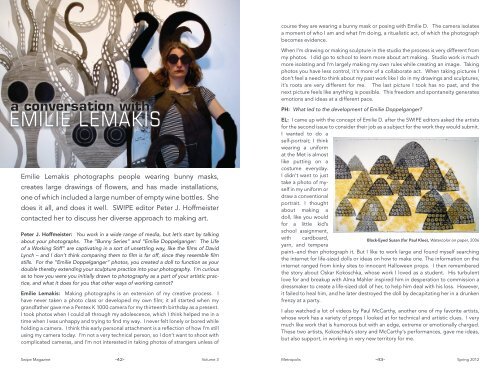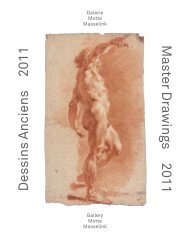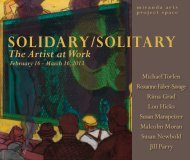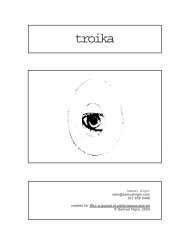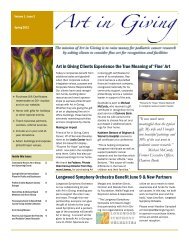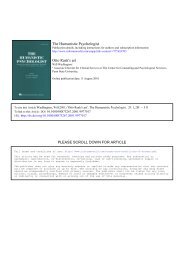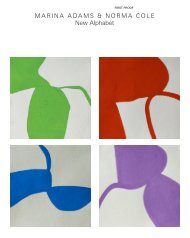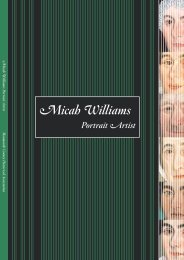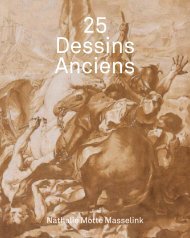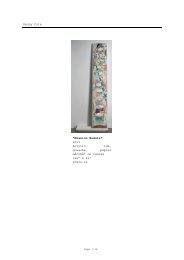EMILIE LEMAKIS - Icompendium
EMILIE LEMAKIS - Icompendium
EMILIE LEMAKIS - Icompendium
Create successful ePaper yourself
Turn your PDF publications into a flip-book with our unique Google optimized e-Paper software.
a conversation with<br />
<strong>EMILIE</strong> <strong>LEMAKIS</strong><br />
Emilie Lemakis photographs people wearing bunny masks,<br />
creates large drawings of flowers, and has made installations,<br />
one of which included a large number of empty wine bottles. She<br />
does it all, and does it well. SW!PE editor Peter J. Hoffmeister<br />
contacted her to discuss her diverse approach to making art.<br />
Peter J. Hoffmeister: You work in a wide range of media, but let’s start by talking<br />
about your photographs. The “Bunny Series” and “Emilie Doppelganger: The Life<br />
of a Working Stiff” are captivating in a sort of unsettling way, like the films of David<br />
Lynch – and I don’t think comparing them to film is far off, since they resemble film<br />
stills. For the “Emilie Doppelganger” photos, you created a doll to function as your<br />
double thereby extending your sculpture practice into your photography. I’m curious<br />
as to how you were you initially drawn to photography as a part of your artistic practice,<br />
and what it does for you that other ways of working cannot?<br />
Emilie Lemakis: Making photographs is an extension of my creative process. I<br />
have never taken a photo class or developed my own film; it all started when my<br />
grandfather gave me a Pentex K 1000 camera for my thirteenth birthday as a present.<br />
I took photos when I could all through my adolescence, which I think helped me in a<br />
time when I was unhappy and trying to find my way. I never felt lonely or bored while<br />
holding a camera. I think this early personal attachment is a reflection of how I’m still<br />
using my camera today. I’m not a very technical person, so I don’t want to shoot with<br />
complicated cameras, and I’m not interested in taking photos of strangers unless of<br />
course they are wearing a bunny mask or posing with Emilie D. The camera isolates<br />
a moment of who I am and what I’m doing, a ritualistic act, of which the photograph<br />
becomes evidence.<br />
When I’m drawing or making sculpture in the studio the process is very different from<br />
my photos. I did go to school to learn more about art making. Studio work is much<br />
more isolating and I’m largely making my own rules while creating an image. Taking<br />
photos you have less control, it’s more of a collaborate act. When taking pictures I<br />
don’t feel a need to think about my past work like I do in my drawings and sculptures,<br />
it’s roots are very different for me. The last picture I took has no past, and the<br />
next picture feels like anything is possible. This freedom and spontaneity generates<br />
emotions and ideas at a different pace.<br />
PH: What led to the development of Emilie Doppelganger?<br />
EL: I came up with the concept of Emilie D. after the SW!PE editors asked the artists<br />
for the second issue to consider their job as a subject for the work they would submit.<br />
I wanted to do a<br />
self-portrait; I think<br />
wearing a uniform<br />
at the Met is almost<br />
like putting on a<br />
costume everyday.<br />
I didn’t want to just<br />
take a photo of myself<br />
in my uniform or<br />
draw a conventional<br />
portrait. I thought<br />
about making a<br />
doll, like you would<br />
for a little kid’s<br />
school assignment,<br />
with cardboard,<br />
Black-Eyed Susan (for Paul Klee), Watercolor on paper, 2006<br />
yarn, and tempera<br />
paint--and then photograph it. But I like to work large and found myself searching<br />
the internet for life-sized dolls or ideas on how to make one. The information on the<br />
internet ranged from kinky sites to innocent Halloween props. I then remembered<br />
the story about Oskar Kokoschka, whose work I loved as a student. His turbulent<br />
love for and breakup with Alma Mahler inspired him in desperation to commission a<br />
dressmaker to create a life-sized doll of her, to help him deal with his loss. However,<br />
it failed to heal him, and he later destroyed the doll by decapitating her in a drunken<br />
frenzy at a party.<br />
I also watched a lot of videos by Paul McCarthy, another one of my favorite artists,<br />
whose work has a variety of props I looked at for technical and artistic clues. I very<br />
much like work that is humorous but with an edge, extreme or emotionally charged.<br />
These two artists, Kokoschka’s story and McCarthy’s performances, gave me ideas,<br />
but also support, in working in very new territory for me.<br />
Swipe Magazine -42-<br />
Volume 3 Metropolis -43- Spring 2012
“IT WAS LIKE ECHOING THE PROCESS OF A<br />
I also have to mention that this is a collaborative project with my friend Nick, who<br />
took the photographs. His technical obsession with lighting transforms a scene.<br />
He also helps me get through the very difficult step of walking around in public<br />
with her; he is very relaxed when I’m very embarrassed. Emilie D. and I would be<br />
lost without him. Lastly, naming her was really hard. I wanted her to have a really<br />
traditional sounding name. Doppelganger, whether you know what it means or not,<br />
doesn’t matter. It could be just a last name. I didn’t want anything hip. Emilie’s a<br />
bit old-fashioned.<br />
PH: I would say that your work is definitely humorous with an edge, there is a visual<br />
wit that is the cornerstone of your practice, and this is what ties everything together.<br />
You drawings are great, and what is funny is that so many of them actually look like<br />
prints. When we were hanging the SW!PE show last year I loved the two Black-eyed<br />
Me and You, Digital print, 2011<br />
Susan drawings you brought so much I hung them next to my work. Even though it<br />
is the name of an actual type of flower, in the context of your work the name almost<br />
sounds ironic, since it sort of has violent undertones, as in giving someone a “black<br />
eye”.<br />
EL: You’re not the only one who has said my drawings look like prints. I like working<br />
in large flat and graphic handmade designs and patterns. I want the drawings to be<br />
imposing visually, and the flowers are no different.<br />
But I never thought of black eyes. It’s just the opposite in a way. When I was a<br />
child, I remember driving on some country road and there were Black-eyed Susans<br />
FLOWER GROWING IN SOIL.”<br />
growing wild along<br />
the side of the road.<br />
My father joked<br />
with my sister and I<br />
that the yellow and<br />
black flowers were<br />
named after my<br />
mother (her name is<br />
Suzy for short). So<br />
I always think of my<br />
mother when I see<br />
that flower.<br />
That memory and<br />
a run in with a<br />
very large patch of<br />
Me and You, Digital print, 2011<br />
Black-eyed Susans<br />
many years later in a friend’s garden were the beginning of using flowers in my work.<br />
I was then working on a now abandoned photo project of me wearing this little old<br />
lady’s mask; I had Nick take my picture in front of the flowers. I really liked the image<br />
so I had the photo developed large, adhered to a shallow wooden box frame then<br />
proceeded to drill holes in the flower to inset electrical lights.<br />
From that piece<br />
a host of flowers<br />
grew. The watercolors<br />
in the SW!PE<br />
show were all started<br />
by a small circle,<br />
then another, until<br />
all the small circles<br />
grew to a large<br />
overall image. It<br />
was like echoing the<br />
process of a flower<br />
growing in soil. This<br />
was followed by the<br />
piece “Red Eyed<br />
Me and You, Digital print, 2011 Blossom”, which<br />
was a stop motion video of the creation of a drawing from beginning to end. Next<br />
came a large erotic drawing called “Fuck Me Flower” with holes in all shapes and<br />
sizes. Then a sculpture of a barbell constructed out of wood decorated with flowers<br />
and drains. I designed a costume and made a video of me exercising with this very<br />
feminine barbell. The piece is called “Dumb Belle”. My most recent flower, “New<br />
Mutations” is like a heavy metal death flower. The flower part is cut paper that I first<br />
covered with red splatters and drawn ink. The stem is painted to the wall so I’m<br />
Swipe Magazine -44-<br />
Volume 3 Metropolis -45- Spring 2012
free to grow to whatever size of<br />
space I choose.<br />
PH: Is there any particular part<br />
of the MET that you find yourself<br />
looking at most? Since I<br />
work at night, I like to quietly sit<br />
on the Modern Art mezzanine<br />
and get completely lost in the<br />
paintings. They just put up a<br />
couple of nice Hockneys.<br />
EL: The mezzanine has some<br />
really great paintings; I like the<br />
new Hockney pool painting a<br />
lot. I think for me I’m looking<br />
at everything now. Surveying<br />
the objects from the beginning<br />
of civilization to present has<br />
broadened my understanding<br />
of what art is and opened my<br />
practice to new ideas. More<br />
recently I have been spending<br />
time with the really early artifacts<br />
in the Ancient Near East<br />
and Greek galleries. What they<br />
created is full of purpose, life,<br />
death and futility. The objects<br />
are very mysterious to me, like<br />
a secret I want to know about.<br />
PH: What are you working on<br />
now? Last time we spoke you<br />
said you were working on some bell drawings.<br />
EL: I like to work on several projects at a time so I have options when I go to the<br />
studio. I’m still working on the bells. I think of them more as poems then drawings.<br />
They are a kind of meditation on death and despair. I’m also finishing a quilt<br />
made of flattened beer cans, which is a companion to a spider web shaped piece I<br />
constructed out of beer caps and wire that hangs on the wall. Choosing the material<br />
for these pieces was inspired by folk art and the huge El Anatsui piece on the second<br />
floor of the MET’s Modern art galleries. Lastly on the low-end art of things Nick and<br />
I are designing our annual holiday card. There is going to be a new addition to the<br />
family, Emilie D is going to have a baby. So I’m in the process of figuring out how to<br />
make a “mini-me” for our card.<br />
Death, addiction and a birth - it sounds very depressing or silly, but it’s life. As Louise<br />
Bourgeois says, “Art is a guarantee of sanity”. I do believe in that. •<br />
Dumb Belle, Video still, 2009<br />
Swipe Magazine -46-<br />
Volume 3 Metropolis -47- Spring 2012


